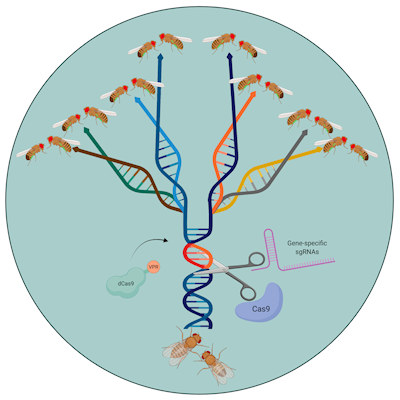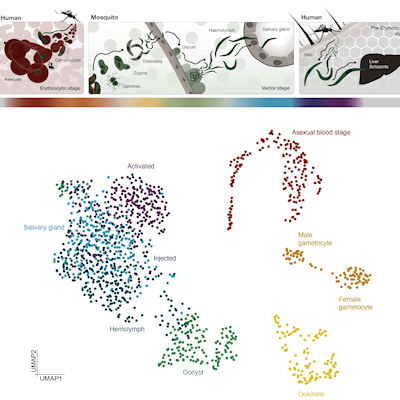June 15, 2021 -- A state-of-the-art microscopy technique has allowed Australian researchers to view parasite invasions in 4D. Using this technology, the team was able to visualize molecular details of how the malaria parasite invades red blood cells. The research, published in Nature Communications on June 15, could have applications for the development of new antimalarial medicines.
Malaria is primarily caused by the Plasmodium falciparum parasite, and results in over 400,000 deaths each year worldwide. The parasite releases tiny merozoites into the bloodstream from P. falciparum-infected red blood cells, and their surface proteins enable attachment to nearby red blood cells.
The merozoite induces rapid and local membrane deformations that enable host cell invasion. Internalization of the infectious merozoite requires significant morphological changes to the host membrane and cytoskeleton. Previous imaging approaches suggest that a parasitophorous vacuole membrane (PVM) forms to allow parasite membrane secretion into the host membrane. But how the specific mechanisms of PVM formation operate remain unclear.
"Understanding in better detail exactly how the parasite invades red blood cells may reveal new ways to stop this stage of the parasite life cycle, potentially leading to much-needed new therapies," explained Kelly Rogers, PhD, head of the Centre for Dynamic Imaging at the Walter and Eliza Hall Institute (WEHI), in a statement.
Lattice light-sheet microscopy
Because dynamic PVM formation is completed in 10-20 seconds, previous approaches to studying the mechanisms have been insufficient. Now, a collaborative team of researchers from the WEHI in Australia developed a method using lattice light-sheet microscopy (LLSM) to track parasite interaction with the host cell membrane during invasion using fast volumetric imaging.
Lattice light-sheet microscopy is an advanced imaging technology that enables researchers to visualize cells and organs in unprecedented detail and in real time. The team developed a dual-camera system that allowed them to image P. falciparum invasion of red blood cells in 4D. The system provided volumetric data with high spatiotemporal resolution, a larger field of view, better signal-to-noise ratio, and less photobleaching. Experts in physics, engineering, and biology worked together to achieve this new approach.
"In the past, the choice of microscope for an experiment had to be a compromise between capturing a lower resolution video, which revealed dynamic processes like shape changes or movement, and capturing much higher-definition still images, which provided much more detail about how the cells and molecules are functioning," said first author Niall Geoghegan, PhD, a lattice light-sheet specialist at WEHI. "LLSM allows us to obtain high-resolution videos of cells, which has been a game-changer for many fields of biological research."
Parasite invasion of red blood cells
The results of the imaging experiment demonstrate that PVM is predominantly formed from the erythrocyte membrane, which undergoes biophysical changes and is continuously remodeled throughout the invasion. The process begins with an influx of calcium, and large protrusions forming from the apex of the parasite.
Next, cholesterol accumulates at the parasite-host interface. Cholesterol has an intrinsic negative curvature, which might help to stabilize the large curvatures on the host membrane during invagination. And lastly, the PVM is formed through hemi-fusion (fusion of bilayers) of opposing membranes.
"The videos we recorded showed the 'push and pull' interactions as the parasite landed on the red blood cell, and then entered the cell in an enclosed chamber -- called a vacuole -- where it grew and multiplied," said Cindy Evelyn, a microscopist at the WEHI Centre for Dynamic Imaging. "There has long been contention in the field about whether the vacuole is derived from the parasite or the host cell. Our research resolved this question, revealing it was created from the red blood cell's membrane."
Most antimalarial therapies and vaccines target the initial binding of malaria to red blood cells.
"By visualizing these processes in more detail, our research may contribute in several ways to the development of new antimalarial therapies," Rogers said. "For example, now that we know that the parasite vacuole relies on components of the red blood cell membrane, it might be possible to target these components with medicines to disrupt the parasite life cycle. This host-directed approach could be one way to bypass the malaria parasite's propensity to rapidly develop drug resistance."
The researchers noted that LLSM may also have applications for viewing other specific steps of parasite invasion that are blocked by potential new drugs. This drug discovery research is an area that they are interested in pursuing in the future.
Do you have a unique perspective on your research related to infectious diseases or drug discovery? Contact the editor today to learn more.
Copyright © 2021 scienceboard.net








